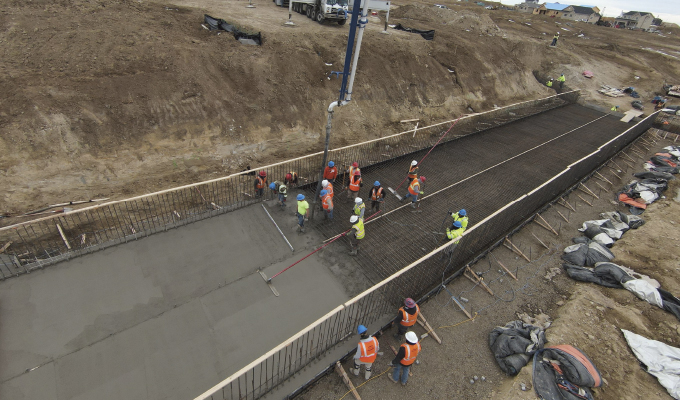Accurate, up-to-date information is essential for profitable construction projects. Decision-makers need access to real-time data to steer the company in the right direction, and those managing projects on the ground need timely reporting on actual production to execute projects efficiently and effectively. However, despite advances in technology, many construction businesses still rely on manual processes and disconnected software that make real-time data sharing impossible.
Making sense of project data across disconnected programs and processes requires hours of additional work and data manipulation. In some cases, data captured in the field is walked, driven, or transmitted to a back-office counterpart who manually enters it into the ERP (Enterprise Resource Planning) platform or software of record.
From delays on the jobsite while data gets processed, to substantially higher project costs and increased risks, the pitfalls of relying on manual processes and non-integrated software are becoming harder to escape—especially as demands on contractors for more streamlined, efficient projects continue to grow.
A noticeable data gap between the jobsite and the office led Coyote Ridge Construction, a Johnstown, Colorado-based heavy civil contractor specializing in underground utilities, excavation, and concrete work, to explore ways to make data accessible to teams in the office and the field. Despite utilizing software to estimate and power back-office functions, the company relied on manual processes to collect field data.
“Our field teams captured production updates on paper forms and brought them to the office where project managers would then transfer the information to spreadsheets,” says Angie Lowe, accounting manager at Coyote Ridge Construction. “Processing the data took up to two weeks, so it always felt like we were shooting in the dark. It’s difficult to make smart business decisions if you don’t know what’s happening in the field.”
After wrapping up the most successful year since opening its doors, the company began looking at ways to work smarter and faster to ensure future growth.
“All of our conversations pointed back to the need to improve how we track production,” says Lowe. “Finding a better way to record production would trickle down to other areas and have a domino effect throughout the company. Continuing to grow and solidify our future meant we had to find a way to understand what was happening in the field daily.”
AUTOMATION EMPOWERS ALL TEAMS
Within four months, Coyote Ridge Construction implemented a new web-based construction ERP solution and an automated field tracking solution to track production numbers and payroll hours from the field.
Coyote Ridge Construction’s field teams now utilize digital field logs to capture productivity, labor hours, equipment, and material utilization. With seamless integration between the ERP solution and the field tracking software, information captured in the field is available to teams in the office. This gives the company a single source of truth to compare daily metrics to schedules and budgets outlined in project contracts and ensure work is proceeding as planned. Actual performance data from the field tracking system now also flows back to the estimating software, improving the accuracy of future bids.
As Lowe and the management team evaluated ERP and performance-tracking options to complement their estimating software, identifying a vendor that could cover and connect everything together emerged as a priority.
“These solutions and the integration between them have dramatically improved our communication and allowed us all to work much more efficiently and cohesively,” says Lowe. “We’ve saved time by automating data capture, and real-time visibility into production has given our field teams a greater sense of ownership of their work. We’ve empowered them with access to the information they need to make data-driven decisions and keep work moving in the field.”
REAL-TIME DATA STREAMLINES ACCOUNTING
Moving to integrated ERP and field tracking software also unlocked new efficiencies in Coyote Ridge Construction’s accounting workflows, from payroll to accounts payable.
“Although improving production tracking was our primary goal, we knew we would see impacts in other business areas,” says Lowe. “Before, we considered hiring another payroll administrator, but now we don’t have to. Timecard information captured in the field flows right into our ERP solution. Automating the workflow saves time, and because of it, we can process payroll for 190 people with one payroll administrator.”
Giving project managers and superintendents the ability to issue approvals from the field has also accelerated accounts payable processes. Approvals no longer need to be sequential; they can be concurrent, so no one approver holds up the chain.
“Data only needs to be entered once, and the accounting team can access what they need to process invoices and payments faster,” says Lowe. “We can view committed job costs, which lessens the need to go to a project manager to approve invoices issued against a purchase order. Now, we’re paying 150 vendors a week electronically, so we’re not only saving time, we’re making sure our vendors are paid quickly.”
Taking advantage of integrated cloud-based technology’s speed and collaborative benefits, Coyote Ridge Construction now understands precisely where projects stand. Both solutions have eliminated multiple sources of inconsistent and out-of-date information, giving the company a single source of truth that can be easily shared in real-time with automated workflows and alerts to executives, managers, accounting professionals, and field teams when they need to see them.
“Across the board, automating processes and making the right data available to the right people at the right time has helped us communicate and collaborate,” says Lowe. “We’ve unlocked efficiencies across the business and increased project profitability, and the processes and technology we’ve put in place give us the peace of mind that we’re well-equipped for growth.”
about the author
Jon Fingland is a vice president and category general manager at Trimble. He has over 20 years of industry experience and has played a pivotal role in Trimble’s connected construction vision, helping to bring together modern technologies and real-time data across the project lifecycle, from design and build to operation and maintenance. For more, visit www.trimble.com.


